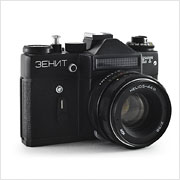KMZ Zenit ET
The KMZ Zenit ET is a single lens reflex camera introduced by KMZ in 1981 as part of a long line of SLRs that bear the Zenit name. The Zenit ET was produced by Vileiskiy Zavod Zenit, a factory just outside Minsk that came about as a joint-venture in 1969 between KMZ and MMZ (which later became BelOMO).













